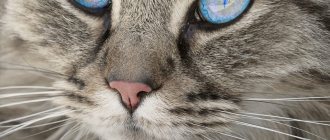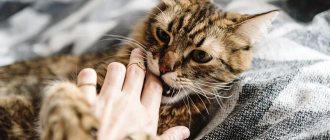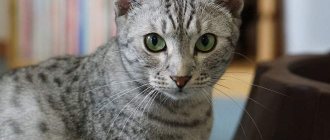Causes and symptoms of various types of eye diseases
There are a huge number of eye diseases in cats.
There are a lot of eye diseases in cats, let's look at the symptoms and causes of the most common diseases.
Wounds and bruises
Cats receive these injuries after fights or falls. Wounds can be deep, superficial and through. The main symptom is redness and swelling, sometimes bleeding.
Inflammation of the eyelids
There are phlegmous and simple inflammation of the eyelids. In the first case, the eyelid swells and purulent mucus flows from the eye. With simple inflammation, the cat scratches the affected eye, the eyelids become red and thickened. It occurs due to vitamin deficiency or eczema, and phlegmatic inflammation is caused by deep wounds and severe scratching.
Turn of the century
Photo. Entropion of a cat's eyelid.
When inversion occurs, the skin of the eyelid turns inward, which causes severe inflammation. If you do not provide assistance to the animal, keratitis or conjunctivitis may develop, and in advanced cases, volvulus develops into a corneal ulcer.
Symptoms of the disease are photophobia and lacrimation, the eyelid swells and changes appearance. Volvulus can be caused by foreign bodies entering the eye, exposure to chemicals, or untreated conjunctivitis.
Conjunctivitis and its varieties
Photo. Conjunctivitis and its varieties.
Conjunctivitis is one of the most common diseases among cats. It has several varieties:
- allergic;
- purulent;
- acute catarrhal;
- follicular.
Allergic conjunctivitis is caused by contact with an allergen. At first, clear discharge flows from the eye, which becomes purulent if left untreated.
Purulent conjunctivitis causes a general deterioration in the cat's condition. There is abundant purulent discharge from the eyes, and the body temperature rises. Animals often experience vomiting and diarrhea.
Acute catarrhal conjunctivitis causes severe swelling and redness of the eyes. The cat is in pain, there is serous-mucous discharge and lacrimation. The main cause is injury; the disease also develops after infections and a lack of vitamin A.
Keratitis and its types
Photo. Keratitis in a cat
Keratitis is a disease of the eye cornea. The most common types of this disease are:
- superficial purulent;
- superficial vascular;
- deep purulent.
With superficial purulent keratitis, the epithelial (upper) layer of the cornea suffers. The cat is anxious and feels constant pain, and photophobia develops. The cornea becomes grayish and swelling appears. This type of keratitis develops after injury.
With superficial vascular keratitis, capillaries grow into the upper layers of the cornea, causing clouding of the eye. The symptoms are the same as for superficial purulent keratitis.
Deep purulent keratitis is a more serious disease caused by microbes that have penetrated the corneal stroma. The cat constantly scratches the affected eye and is afraid of light. The cornea takes on a white-yellow hue. Vascularization (growth of capillaries into the cornea) is observed. The causes of the disease are infections and injuries.
Corneal ulcer
Photo. Corneal ulcer in cats.
Deep wounds and infections lead to corneal ulcers. Often this disease is a complication of purulent keratitis. There are two types of corneal ulcers: perforated and purulent. The main symptom is severe pain, so the animal will be very restless.
With a perforated ulcer, purulent discharge is observed from the eyes, and the cornea becomes gray-blue. Sometimes there are spasms of the eyelids and fear of bright light. After the ulcers heal, scars form.
Glaucoma
Photo. Glaucoma in cats.
This disease can be congenital, closed-angle or open-angle. The main symptom is a constant or periodic increase in pressure inside the eye. With open-angle glaucoma, the cornea becomes cloudy, colorless and loses sensitivity.
The eyeball greatly enlarges and hardens. With angle-closure glaucoma, the cornea becomes cloudy in a ring-like manner, and vascularization develops. The causes of this disease are: complications of deep purulent keratitis, hemorrhage, swelling or dislocation of the lens.
Cataract
Photo. Cataracts in cats
A cataract is a clouding of the lens. It comes in several types:
- congenital;
- toxic;
- traumatic;
- symptomatic.
In the final stages of the disease, the animal has difficulty seeing in the affected eye. The lens becomes white or bluish. Cataracts develop after infections, as well as after inflammation and trauma. It often affects older cats.
Causes and mechanism of development
Panophthalmitis can be caused by exogenous or endogenous causes. In both cases, an infection penetrates into the eyeball. The causative agents are staphylococci, streptococci, Pseudomonas aeruginosa and other pathological microorganisms. They can enter the eye tissue through a penetrating injury (for example, when the eye is damaged during a cat fight or a piece of glass enters the cornea), or a burn.
Panophthalmitis can also develop against the background of:
- infectious uevitis (inflammation of the choroid of the eye),
- bacterial keratitis (inflammation of the cornea of the eye),
- purulent conjunctivitis,
- chlamydial trachoma.
When a pathogen penetrates the tissue of the eyeball, protective mechanisms are activated in the cat’s body. The immune system begins to produce large quantities of E-lymphocytes, antibodies, the formation of which is accompanied by a powerful release of inflammatory mediators. However, due to the increased vulnerability of the delicate tissues of the organ of vision, all layers of the eyeball are very quickly damaged, up to complete destruction (“melting”). With further development of the disease, the purulent process also affects the surrounding soft tissues (eyelids, eye muscles).
Panophthalmitis in a cat
Tips for caring for your cat's eyes
To keep your cat's eyes healthy, you must follow the rules of caring for them.
To ensure that your pet's eyes are always healthy, you must follow certain rules.
Here are recommendations from veterinarians and experienced cat owners:
- do not use cotton wool to cleanse your eyes, as its fibers will cause increased lacrimation; it is better to use cotton swabs;
- do not rinse your cat’s eyes with water, this will disturb the microflora;
- For care and treatment, use only those medications that are intended for the eyes;
- You should not use chamomile infusion to wash your eyes, as it can cause baldness of the eyelids;
- do not interrupt treatment that has already begun;
- Monitor the condition of your cat’s eyes – the appearance of a third eyelid indicates the development of the disease.
Proper eye treatment cannot be carried out without an accurate diagnosis. If your cat develops alarming symptoms, take your pet to the veterinarian. Don't forget that if left untreated, some diseases can lead to complete or partial blindness.
Why do my cat's eyes hurt?
The causes of the disease may be due to external factors, breed and predisposition to any ophthalmological disease. At any age, the disease requires treatment. Otherwise, the animal may become completely blind: cell decay and protein decomposition begin.
Possible causes of the disease
- Metabolic disease.
- Problems with intraocular fluid.
- Injuries, concussions, blows, bruises of varying degrees.
- Congenital pathology, if infectious diseases were transmitted to the kitten during birth.
- Old age. With age, metabolism slows down and the eye organ becomes less protected from external influences.
Extreme sports people and mixed breeds are most susceptible to eye diseases
Extreme sports people and mestizos are the most susceptible to diseases. Less commonly, eye pathology is observed in the “British” and “Scots”. Isolated cases occur in outbred cats. The main point, from the point of view of differentiating eye diseases, is the factors that determine the presence or absence of infection:
- Conditions of detention.
- Preventive measures.
- Stress levels matter most to cats.
- The presence of a source of the pathogen and its concentration in the environment.
- Concomitant diseases that cause predisposition to the infectious process.
Taking these factors into account, we can conclude that in inadequate conditions of detention in the absence of preventive measures, when the animal is in a stressful state, there are greater risks of eye infectious diseases.
Stress can cause eye problems in cats
Causes of cat allergies
There are many reasons for allergies to cats, some of them are:
- Various manifestations of allergic reactions are a hereditary disease. If parents have symptoms of a cat allergy, then it is almost certain that their children will also get sick;
- Age matters a lot. Children are the least protected from various allergenic irritants. Therefore, they are at greater risk of contracting cat allergies than adults;
- Frequent and protracted chronic diseases, polluted environment and poor-quality food products, weakened immune system lead to allergies;
- Infection of the body with helminths that were not removed in time from domestic cats. The worst thing is that even a very small child can easily become infected. This happens if someone from his environment came into contact with a sick cat, and then washed his hands poorly or did not wash his hands at all.
© shutterstock
Studies have revealed that cats, kittens and female cats are greater carriers of allergens than dogs. Moreover, many are mistaken in believing that it is animal fur that is allergenic. In fact, saliva, urine and dead skin particles from cats cause various allergic and painful reactions in the body.
Cats are big fans of walking outside. It is from their walks that they bring pollen, poplar fluff, and road dust onto their fur. After such walks, an allergy to the cat appears.
Symptoms of a cat allergy
Our body gives a variety of reactions to the appearance of an allergen inside it. It could be:
- The most common runny nose, which is often confused with colds. And while a person is taking treatment for a cold, the allergy to the cat progresses;
- Nasal congestion, which many also perceive as a cold or simply hypothermia;
- The eyes begin to water, itching and redness appear. Such symptoms can even be confused with conjunctivitis and, again, the wrong treatment may be taken;
- Frequent shortness of breath, signs of suffocation and difficulty breathing are some of the symptoms of an allergy to cats. These may be manifestations of bronchitis. And if there are cats in the house, then an allergy to them cannot be ruled out;
- Attacks of dry cough occur, especially at night, when the allergy progresses most. Or wheezing and whistling in the lungs - this is an allergy to cat fur in adults;
- The throat becomes inflamed, the tonsils swell and hurt like a sore throat, it hurts to swallow, it’s difficult to speak and breathe;
- The nervous system is destroyed, sleep is disturbed, and a state of loss of strength appears.
All these symptoms cannot be ignored, otherwise, if you do not take treatment in time, allergic asthma may appear. In rare cases, allergies to cats lead to angioedema.
Many people often overlook the signs of a cat allergy because they consider allergies to be a spring disease. This is all a wrong, erroneous opinion. This disease haunts a person all year round.
At the first suspicion of an allergic reaction in the body, you should immediately seek help from an allergist. You will need to be examined to find out the causes of the body's allergic reaction. After all, this is not just protection from allergenic irritants. This is a bell, a warning about a very serious disease.
© shutterstock
It's sad, but once you get an allergy, you won't be able to get rid of it forever. But it is always possible to significantly alleviate the body’s condition during periods of exacerbation and strengthen the immune system. After all, an allergy to cats, like all other diseases, definitely needs prevention and treatment.
Rules of conduct for allergy sufferers with cats
If someone in your family is allergic to cat fur. And a beloved pet already lives in the house, and besides, it is a hypoallergenic breed. Anyway, you don’t need to let your guard down and follow the following rules to avoid exacerbation of allergies to cats:
- At any time of the year, in any weather, it is necessary to ventilate the room. They do this in the morning, at lunch and in the evening. It will be enough to open the window for just five minutes;
- As little as possible, collect things in your home that attract dust and cat hair (stuffed toys, furniture ottomans, carpets, curtains, down and feather pillows and blankets). If such interior items are present in the home, they need to be cleaned as often as possible;
- It is advisable to purchase furniture for your home with a leather covering, which can be easily wiped with a damp cloth;
- Put all personal belongings and clothes, bedding in closets so that cat hair does not cling to them;
- Contact the cat as little as possible, and after each cuddle with your pet, wash your hands and wash your face. It would be ideal to change clothes so that the fur particles do not irritate the human body for the next day;
- Every day, be sure to carry out light wet cleaning of your home with the addition of special products. Also vacuum, clean, and humidify the air. After all, nothing repels allergens like fresh air and a clean, damp room.
© shutterstock
Try to accustom the cat to its own separate, equipped sleeping place. So that they do not enter the bedroom at all, and certainly not comb themselves on the bed of their owners.
The same applies to the space reserved for cats to defecate. If the animal is not walked, in order to avoid the spread of allergens throughout the apartment, they are also present in the animal’s urine. You need to place the litter tray in a specially designated room, preferably one that is well ventilated, and clean it as often as possible.
If signs of allergy do appear, you need to take preventive measures with tailed household members:
- Every week, bathe the cat with special shampoos and hypoallergenic products under running water. If it is a regular shampoo, it can, on the contrary, cause peeling and irritation of the animal’s skin, which will lead to an exacerbation of allergies to it;
- In addition to bathing, cats need to wash their faces every day.
- Review and balance your cat's diet. Food should not cause vitamin deficiencies, allergies, or hair loss in the animals themselves, so as not to provoke an allergy in the owner to his animal;
- It is mandatory to regularly undergo preventive examination of the animal and get vaccinated against helminths and other parasites;
- A neutered cat is the least dangerous in terms of allergies, so owners resort to this procedure so as not to get rid of their fluffy little bundle of joy.
As you know, females are also the least allergenic. Cats with light fur are least likely to cause allergic reactions.
© shutterstock
In what cases is it necessary to contact a veterinarian?
If there is no appetite and lethargy, you should show the animal to the veterinarian.
If the cat, in addition to the desire to hide in a dark place, has the following deviations, it is necessary to show the animal to the veterinarian:
- Lack of appetite;
- Increased thirst;
- Refusal of water;
- Heavy discharge from the mouth, nose, or eyes;
- Purulent discharge;
- Changes in the consistency and smell of excrement;
- Change in the color and odor of urine;
- Dull coat, baldness;
- Skin rashes, suppuration;
- Frequent scratching, licking;
- Cough, sneezing, vomiting;
- Lethargy, drowsiness;
- Loss of coordination;
A cat’s desire to hide in a dark place, especially when it is not eating or drinking, is caused by many reasons. An attentive and caring owner will respond in a timely manner to changes in the pet’s behavior and will do everything possible to restore a comfortable environment.
Treatments for cat allergies
After contacting the clinic, appropriate examinations will be carried out. It is necessary to do tests for allergenic irritants. Maybe the cat has nothing to do with it.
Allergies are treated with medications. The doctor will prescribe tablets and sorbents, or recommend antihistamine creams and gels. You can buy them at any pharmacy, freely available, without a doctor’s prescription. For more severe signs of cat allergy, or intolerance to pills, a course of immunotherapy may be prescribed.
Many people successfully cope with the symptoms of allergies to cats by resorting to traditional medicine, drinking various herbal teas and decoctions:
- A decoction of nettle leaves helps cleanse the blood, stops the spread of allergens in the body, and removes unpleasant symptoms. The prepared decoction is drunk before meals, half a tablespoon, four times a day. To prepare it, you need a tablespoon of dried nettle leaves, pour into a saucepan. Then pour a liter of boiling water and simmer over very low heat for no more than five minutes. Afterwards, leave for an hour. Store the prepared broth in the refrigerator.
- A decoction of wild chamomile flowers is used as a lotion and for washing with various types of rashes and soothing itching. Pour 50 grams of dried herb into a liter jar and fill it to the top with boiling water. Cover with a lid or towel and leave to steep for about an hour. Use the prepared decoction three times a day.
Allergies are one of the oldest, long-understudied, human ailments. Modern medicine has recently studied the mechanism of the disease.
Allergy is not a disease in the classical sense, but a series of conditions caused by an inadequate response of the immune system to virtually harmless substances.
Hypersensitivity to allergens is expressed in increased production of immunoglobulins (antibodies, in particular protective protein E). Immunoglobulins work to protect the body from unwanted “guests”, suppressing infections, helping to destroy toxins, worms and other parasites, and various foreign substances.
Treatment
Treatment should begin immediately after the first symptoms appear. Otherwise, sepsis or bacterial meningitis may develop, and this leads to the death of the pet. First, drug treatment is prescribed; in advanced cases, surgery is required when the eye is completely removed. You cannot provide first aid yourself; this may worsen the cat’s condition. Treatment is carried out only in a hospital setting, in a veterinary clinic.
Basic treatment
In the initial stage of the disease, a novocaine blockade is performed to reduce pain. The painkiller is injected behind the apple. To enhance the effect, sulfacyl or syntomycin ointment is added. To eliminate the infection, the cat is given orally (or injected) with broad-spectrum antibiotics:
- "Amoxiclav";
- "Biosol";
- "Neomycin";
- "Neopen";
- "Ampicillin";
- "Tetracycline";
- "Gentamicin";
- "Bicilin";
- "Streptomycin".
The duration of antibacterial therapy depends on the stage of the disease and the pathogen. The minimum treatment time with antibiotics is a week. Most often, medications are administered by injection; it is difficult to force your pet to swallow pills. To avoid addiction, after 14 days the antibiotics are changed to another drug.
Why does an allergic reaction occur?
Usually the content of antibodies in the blood is not significant, and when there are too many of them, painful symptoms of varying degrees of severity appear. What does it look like?
Antibodies “pounce” on “strangers” (they are foreign proteins, allergens) and settle on the membranes of “mast cells” where active substances are stored.
Histamine, an active substance that takes part in the destruction of foreign proteins, is actively released from mast cells. During the conflict between “friends” and “strangers,” a focus of inflammation arises, where the neutralization and utilization of foreign molecules occurs. And in the case of a harmless allergen, the body turns on the immune system, in fact, against itself.
Externally, this process manifests itself in the form of inflammatory reactions: rash, itching, production of mucus in large quantities and its secretions, cough, runny nose, conjunctivitis, and various edema. However, such a vigilant immune system is not so bad.
Medicine claims that people suffering from allergic reactions are much less susceptible to malignant tumors.
What causes the disease? How quickly does it appear?
Almost anything can be an allergen: from household and medicinal chemicals to pollen, particles of other people's sweat, alcohol, dust, wool, metals and other substances. With the deterioration of the environment, allergies are manifested in more and more people. This is how the body protects itself from an aggressive external environment.
According to statistics, today one out of five inhabitants of the planet is susceptible to allergies. Among the “leaders” are allergies to animals, and especially to cats. How to recognize a pet allergy?
Unfortunately, it is impossible to immediately determine this. Usually, an allergy becomes clear when the dependence of the appearance of ailments on contact with an animal is identified. This is possible only after temporary observation.
Heredity indirectly influences allergies. If you have a family history of allergies, the risk of allergies increases.
Moreover, the allergens may not necessarily be the same: the nature of the ailment is rooted in the behavior of the immune system, and not in specific substances and reactions to them.
The reaction to cats is expressed in different ways, but the skin, eyes, respiratory tract and blood are primarily attacked. The reaction can vary in intensity: from mild itching, rhinitis or redness of the eyes to severe consequences in the form of anaphylactic shock, Quincke's edema, weeping ulcers similar to eczema and other acute ailments.
You may be interested in an article about whether there are allergies in infants and newborns.
Photophobia is normal
Kittens are born blind. Their eyes are closed for a reason, they continue to form and prepare to meet a serious, irritating factor - light. The pupils, which dilate and contract, are partly responsible for the normal perception of light and visual information. When a kitten just opens its eyes, its pupils do not have time to adjust to the brightness of the light. You can see how the babies turn their faces away from the light sources and try to climb into the far corner of the nest. This phenomenon is quite natural and is not associated with photophobia.
The cause of photophobia in adult cats that cannot be ignored is pregnancy. Cats expecting offspring behave very differently, some become more sociable, others more irritable. However, all pregnant cats have one thing in common: the closer the due date, the stronger the desire to build a nest.
Cats of certain breeds do not arrange a nest on their own, but wait for these steps from the owner. Usually the pet is very worried, meows, calls the owner and tries to take it to the site of the proposed nest. In this case, your task is to arrange a soft bed and monitor your pet, since she will also count on you during childbirth.
A cat that sets up a nest independently chooses a dark place and sits in it for a long time. Your task is to read thoughts and free up the space you like for arranging a nest. Believe me, this is in your best interest, since for most expectant mothers the shelf with your clothes seems to be the ideal nest. To prevent the cat from hiding, she needs help setting up a nest:
- Make a box with three high sides and one low.
- Cover the box with soft materials; you can lay a moisture-absorbing diaper on the bottom.
Tip: if your cat is pregnant and often hides, you need to move bowls with water and food closer to the chosen shelter, so the cats will be more comfortable and calmer.
Allergy to cats: symptoms
The first signs of an allergy to cats may appear immediately, in acute form, or maybe after some time.
- The slow development of the disease is relatively safe.
It can grow gradually, acquiring new “surprises”. Sometimes, after an abrupt cessation of contact with the pet, washing clothes and linen, thorough wet cleaning and ventilation of the room, the reaction subsides and disappears. In such cases, regular antihistamines and precautions for the future are sufficient. - Immediate acute reactions are dangerous.
Since the body may not be able to cope with the pace and intensity of the allergic reaction, the consequences can be fatal. Therefore, in the event of a rapidly growing illness, it is necessary to call an ambulance and provide the allergy sufferer with qualified medical care immediately.
The manifestation of allergies to cats can be different, depending on the nature of the contact:
- If a person strokes a cat, the skin may react, itching, sometimes redness, a slight rash, like hives.
With prolonged contact, weeping blisters may appear. If a pet scratches, a strong inflammatory process may occur at the site of contact, and severe and painful swelling may occur at the site of skin damage. - If cat protein gets into the eyes, conjunctivitis may develop.
It can also be expressed with varying severity: from redness of the eyes, itching, burning, photophobia, lacrimation - to glassy edema on the surface of the cornea, inflammation of the blood vessels of the eyes, severe swelling of the inner surface of the lower and upper eyelids, and even blepharitis.In critical cases, the eyes may also discharge a sticky fluid similar to pus and white thread-like protein clots that cause pain. Blinking can be painful.
- Often cat allergen affects the respiratory tract.
This manifests itself as allergic rhinitis, severe bronchitis, bronchial asthma. A person sneezes, a runny nose appears, sometimes the nasopharynx becomes inflamed and swollen, the tonsils swell, and it becomes difficult to swallow.There may be a dry cough, itching in the trachea, difficulty breathing, suffocation, a feeling of lack of air, severe wheezing and wheezing when exhaling with the urge to cough.
Such conditions are unsafe, and if contact with the pet continues, bronchial asthma may occur, with attacks of suffocation, and in its extreme - very dangerous - manifestation, you can develop Quincke's edema, and this is a real threat to life.
- The blood reaction to cat protein may be limited to a slight increase in temperature, or may manifest itself as a state similar to the onset of the flu, with chills, heaviness in the bronchi, a raw sensation throughout the body, general malaise and headache.
How does cat allergy manifest in adults and children?
The signs of an allergy to cats are almost the same in both adults and children. The difference is in the nuances and degree of danger. A small child cannot explain what is wrong with him. What should you pay attention to?
- Breathing during an allergic attack in children is often disrupted: difficult inhalation makes the child literally “gasp” for air, and exhalation becomes difficult, especially at the end. You can ask the child to exhale sharply until the end - and wheezing will be heard without a stethoscope.
- If a child rubs his eyes, it is necessary to pay attention to the blood vessels, the condition of the sclera, and the internal mucous surfaces of the eyes. The first signs of conjunctivitis should alert you.
- Scratches are very dangerous. If a cat scratches a child, the wound must be treated immediately. At the first signs of increasing swelling, you should call a doctor and isolate your pet.
- When an acute process is started, cyanosis may occur - darkening and cyanosis of the skin, indicating oxygen starvation due to suffocation. In such cases, you should immediately call an ambulance.
- Emergency medical care for a child with an allergic reaction is also necessary if his body suddenly begins to swell.
The most dangerous type of reaction to an allergen is Quincke's edema. Typically, swelling affects soft, loose tissues: the eyelids, lips, cheeks, neck swell, the arms, legs, and areas of the body where the genitals are located become swollen. This condition requires immediate medical intervention and, most often, hospitalization. Of course, the idea of keeping an animal at home should be forgotten forever.
Communication between children and animals has its own characteristics. The earlier it begins, the lower the risk of allergies. In addition, children often “outgrow” the disease, since the young body quickly changes and adapts to the surrounding space.
For adults, alas, it is more difficult to get rid of allergen intolerance, so if you decide to leave your pet in the house, you need to reduce contact with “cat protein” to a minimum, do not allow the animal to sleep in the bed, and maintain sterile cleanliness in the cat’s “latrine.”
How is the treatment carried out?
Surgical intervention
Panophthalmitis is dangerous due to the development of bacterial meningitis or sepsis, which leads to the death of the animal, so therapy must be carried out quickly.
Since the disease is characterized by purulent melting of tissue, the affected visual organ should be removed. Methods used:
The damaged organ can be removed by exenteration.
- Evisceration. All structures of the eyeball are eliminated - the retina, lens, vitreous body, and uveal tract.
- Enucleation. It is characterized by excision of the eyeball and partial removal of the auxiliary apparatus.
- Exenteration. A complete excision of the organ is carried out, as well as surrounding tissues - muscles, nerves, eyelids, blood vessels, lacrimal canal. After surgery, the skin around the empty eye socket is stitched and a suture is placed.
Drug treatment
All medications are prescribed by a veterinarian; self-medication by the pet owner can aggravate the condition. To save the cat's organs of vision, the cat is prescribed eye medications and antibiotics shown in the table:
| Pharmgroup | Veterinary medicine |
| Sulfonamides | "Streptocide" |
| "Sulfalen" | |
| "Biseptol" | |
| "Sulfadimezin" | |
| Ethazol sodium | |
| Antibiotics | "Zoetis Synulox" |
| "Amikacin" | |
| "Gentamicin" | |
| "Enroxil" | |
| Ophthalmic drugs | Tetracycline ointment |
| "Anandin" | |
| "Dekta-2" | |
| "Gentafarm" | |
| "Levomekol drops" |
Which cat breeds are safe?
Since the allergen is cat protein and not fur, the very fact of a cat being in the same residential area with vulnerable allergy sufferers becomes hazardous to health.
When choosing pets, the question arises: which animals are safe in terms of allergens. The answer may disappoint animal lovers. There are no completely hypoallergenic cats. Even a “bald” representative of the cat family can bring a person to a serious attack.
True, there are interesting observations:
- Kittens usually do not cause a violent defensive reaction in the body, and it proceeds easily, without acute symptoms. The older the pet, the more aggressive its protein.
- If there is not one, but several animals in the house, the allergic risk is reduced.
- Males cause more severe consequences. This may be due to the habit of cats to “mark” their territory with small portions of urine. It has been noticed that neutered cats provoke illnesses less often and to a lesser extent.
- Individuals with white coats rarely cause trouble of this kind, even if they are fluffy and long-haired.
- The risk is reduced if you take care of the cat, keep it and all cat accessories clean, ensure that the animal’s skin does not peel, and comb it. True, all these hygiene procedures should not be performed by a person suffering from allergies. It is better for him to reduce direct contact with the animal to a minimum.
An allergy to cat fur is not fatal. If the painful symptoms do not go beyond the “red line”, where we are talking about a threat to health and life, you don’t have to part with your furry or hairless pet forever.
True, you will always need to take into account the risk of an allergic attack, have appropriate medications on hand, consult a doctor from time to time, and strictly observe the hygiene of your home, your pet, and your own. It is advisable not to let your pet into places where a vulnerable person is most often: bedroom, office, kitchen.
The ideal option is to live in a private house, when the cat has the opportunity to be outside most of the time.
The cat's eyes are itchy
When is veterinary help needed?
In some cases, such diseases can be cured without medical intervention at home. But there are situations when refusing the help of a veterinarian can cost a pet’s life (usually this is due to the need to remove the eyeball):
- development of a purulent process (phlegmon or abscess);
- late stages of glaucoma;
- chemical or thermal burns;
- irreversible traumatic damage.
Surgical treatment is carried out under general anesthesia, after the process is completed, stitches are applied. Depending on the extent of the lesion, the following types of operations are distinguished:
- enucleation (only the eye is removed, the eyelids and muscles remain);
- evicseration (the surgeon cuts out the contents of the eyeball, the outer membrane is not affected);
- exenteration (only the bony walls of the orbit remain).
My grandmother’s cat, who lives in a private house, got into a fight with other cats, as a result of which his lower eyelid was completely turned out: his eye was practically invisible due to the large amount of pus and ichor. We brought the pet to the city to see a veterinarian. At first, the doctor wanted to remove the eye to prevent blood poisoning from developing, but the organ was saved. During the operation, the surgeon stitched the lower eyelid, as a result of which everything returned to normal, but we were warned that the cat could develop a cataract and his vision would completely disappear. Now more than 8 years have passed since this intervention: the cat sees perfectly with the damaged eye.
As a result of the injury, the lower eyelid was completely inverted











